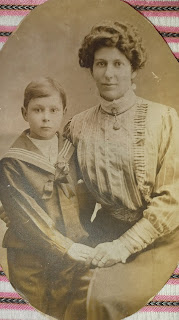As the title of this blog says, the family to which we belong—the descendants of Dave and Sandy Ritchie—is very small. In the words of my mother and aunt, this is because both of their parents were only children. Or so they believed. New information turned up in the course of my research which suggested that my grandmother had a stepsister from her father's first marriage.
I wrote previously about this person, Caroline Emma Sanderson, but wanted to confirm my findings. So I hired a professional genealogist, Janice Heppenstall from English Ancestors, to go through the facts I had gathered and expand on them.
Janice confirmed that my great-grandfather Charles Sanderson, born in 1857 in York, married his first wife Emma Elsey in 1879. The couple lived in Roundhay, Leeds, and welcomed Caroline into the world in 1880. Janice pointed out that they had been very clever in naming the child. Not only was she named after her mother but she was named after her father too; "Caroline" is the adjective used to relate to Charles I and Charles II in the United Kingdom, meaning "of or relating to Charles". This fascinating piece of trivia seems to signal a strong sense of relationship and pride within the family.
I also learnt that Charles' wife Emma died in 1900 in Surrey. This was new information because, although I knew about Charles and Caroline appearing on the 1901 census for Bethnal Green, I had assumed that they moved to London after Emma's death. Evidently, they had moved south sometime in the decade between the censuses. On reflection, this made sense. Emma's parents lived in Surrey, and it would have been natural for them to want to have their granddaughter closer to them. The move would have made sense from an economic point of view too, because there was surely good work to be had for an experienced coachman in the capital.
Caroline was 20 at the time her mother died. She stated her occupation as "Household duties" in the census the following year. It must have been frustrating for her, the daughter of a well-travelled military man, to stay at home and care for her grieving father. It was doubtless a huge relief when Charles met and married my great-grandmother Florence Wilson in 1903.
But now there were two women in the house. Caroline, aged 23, and Florence, aged 28, could not have found it easy. Caroline, who had been raised as an only child, was likely accustomed to being in charge, whereas Florence, who was the third of seven children, was probably used to choosing the path of least resistance.
As the two women were attempting to work out their differences, big changes were happening in the city. The District Railway and Circle Line began converting their passenger operations from steam to electric power. Aldwych was being redeveloped and buildings were being removed to make way for the new, much wider Kingsway. As time went by, the Bakerloo Line was opened, as was The Ritz Hotel in Piccadilly, and the stage play Peter Pan or The Boy Who Wouldn't Grow Up premiered at the Duke of York's Theatre. In Manchester, the Women's' Social and Political Movement, under the direction of Emmeline Pankhurst was getting off the ground, later to be known as the Suffragettes. Meanwhile, further afield, the 1904 Summer Olympics took place in St Louis, Missouri; Theodore Roosevelt was elected as President of the United States; Russian workers began protesting against Tsar Nicolas II's rule in St Petersburg; Albert Einstein completed his scientific paper on the quantum theory of light; and the Cairo-Cape Town Railway was officially inaugurated.
It is possible that none of this meant much to Caroline, though. She had fallen in love with a career soldier named Frederick Sanderson and was preparing to tie the knot. Their marriage took place at the St Pancras Register Office in May 1905, just four months after the birth of my grandmother Sandy. I can picture the wife-to-be leaving her stepmother's home with hardly a backward glance. Charles' new baby was 24 years younger than Caroline, and the doting parents probably got on her nerves. Besides, baby Florence was more like a niece than a member of her own generation.
As for my great-grandmother Florence, I imagine she felt a weight lift off her shoulders as she turned back into the house and anticipated finally being the mistress of her own domain.
Photo credit: Suffrage Caravan Tours, Bridlington, 1908 by LCE LibraryLSE Library.




